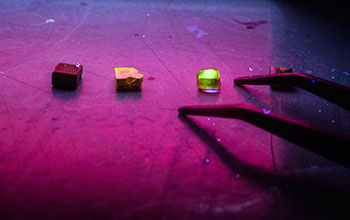Multimedia Gallery
3 crystals of methylammonium lead tribromide illuminated by ultraviolet light
Three crystals of methylammonium lead tribromide illuminated by ultraviolet light. High-quality crystals suitable for X-ray detection glow green when struck by an ultraviolet laser, as illustrated by the crystal at far right.
More about this image
A study led by University of Nebraska-Lincoln (UNL) engineer Jinsong Huang revealed a crystalline material that is four times more sensitive to X-rays than leading commercial detectors. Known as methylammonium lead tribromide, the material can detect an X-ray dose about 11 times lower than that required for many medical applications.
X-rays are used for everything from diagnosing bone fractures to revealing tumors in tissue to helping keep the country safe from terrorism. But the radiation in X-rays can also damage tissue and increase the lifetime risk of developing cancer, particularly in those exposed at a young age, according to the National Institute of Biomedical Imaging and Bioengineering. Huang and colleagues are exploring methylammonium lead tribromide--a material belonging to a family of compounds known as perovskites--as a candidate for limiting this exposure. Huang has studied the material since 2013 in an effort to improve the performance of solar cells and photodetectors.
"If you look at the history of X-ray detectors, the materials used for them are usually also good for photovoltaic devices," said Huang, a Susan J. Rosowski associate professor of mechanical and materials engineering. "This material is almost perfect for X-ray applications."
The study by Huang, which was published in Nature Photonics, reports that properties of the material could make methylammonium lead tribromide a substantial upgrade over amorphous selenium, a material that Huang calls a "workhorse" of the X-ray detector industry.
The research was supported in part by the National Science Foundation (grant CBET 1437656).
To learn more about this research, see the UNL news story New crystal is four times more sensitive to X-rays. (Date image taken: March 2016; date originally posted to NSF Multimedia Gallery: Nov. 15, 2016)
Credit: Craig Chandler/University Communications, University of Nebraska-Lincoln
See other images like this on your iPhone or iPad download NSF Science Zone on the Apple App Store.
Images and other media in the National Science Foundation Multimedia Gallery are available for use in print and electronic material by NSF employees, members of the media, university staff, teachers and the general public. All media in the gallery are intended for personal, educational and nonprofit/non-commercial use only.
Images credited to the National Science Foundation, a federal agency, are in the public domain. The images were created by employees of the United States Government as part of their official duties or prepared by contractors as "works for hire" for NSF. You may freely use NSF-credited images and, at your discretion, credit NSF with a "Courtesy: National Science Foundation" notation.
Additional information about general usage can be found in Conditions.
Also Available:
Download the high-resolution JPG version of the image. (1.9 MB)
Use your mouse to right-click (Mac users may need to Ctrl-click) the link above and choose the option that will save the file or target to your computer.

 All images in this series
All images in this series